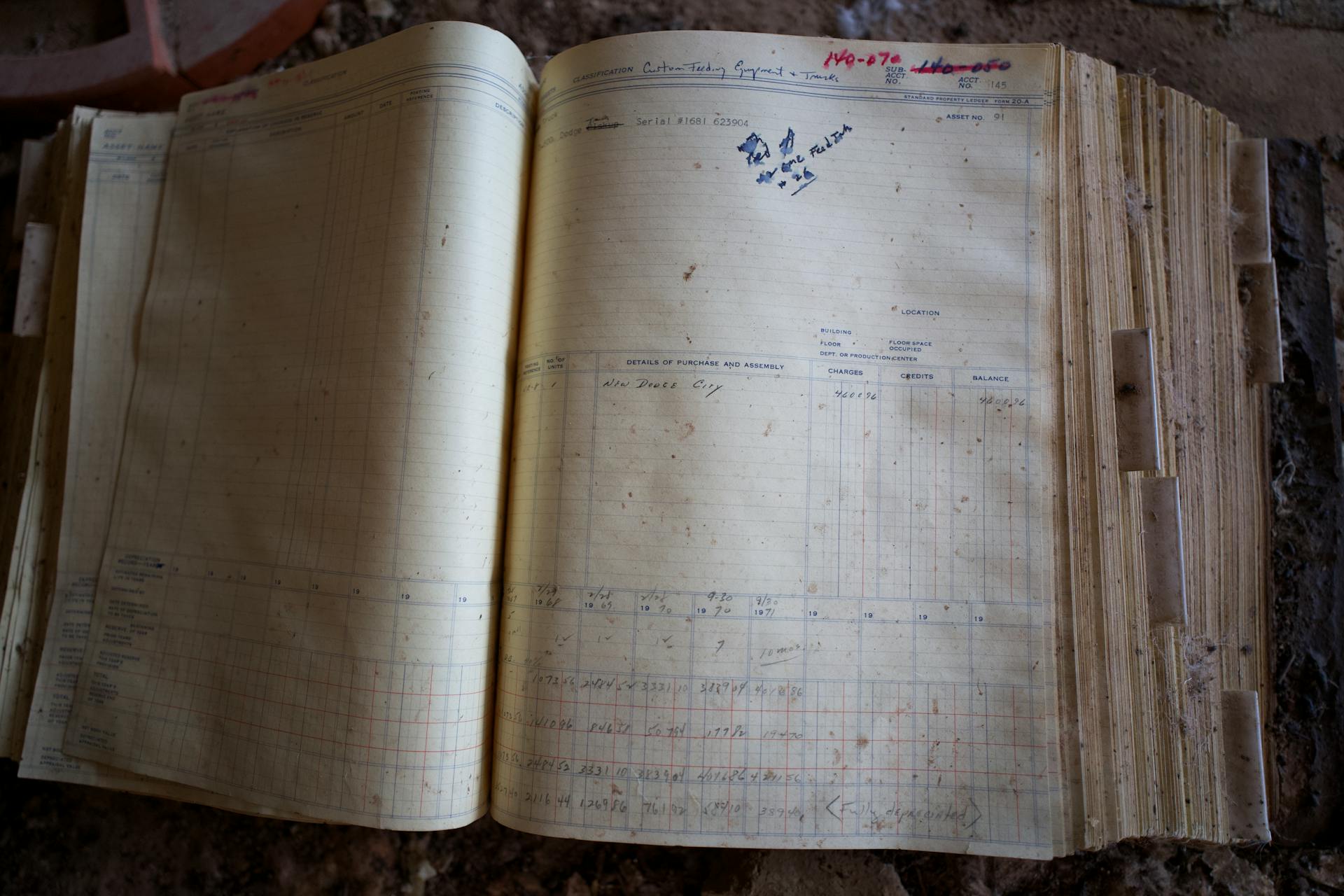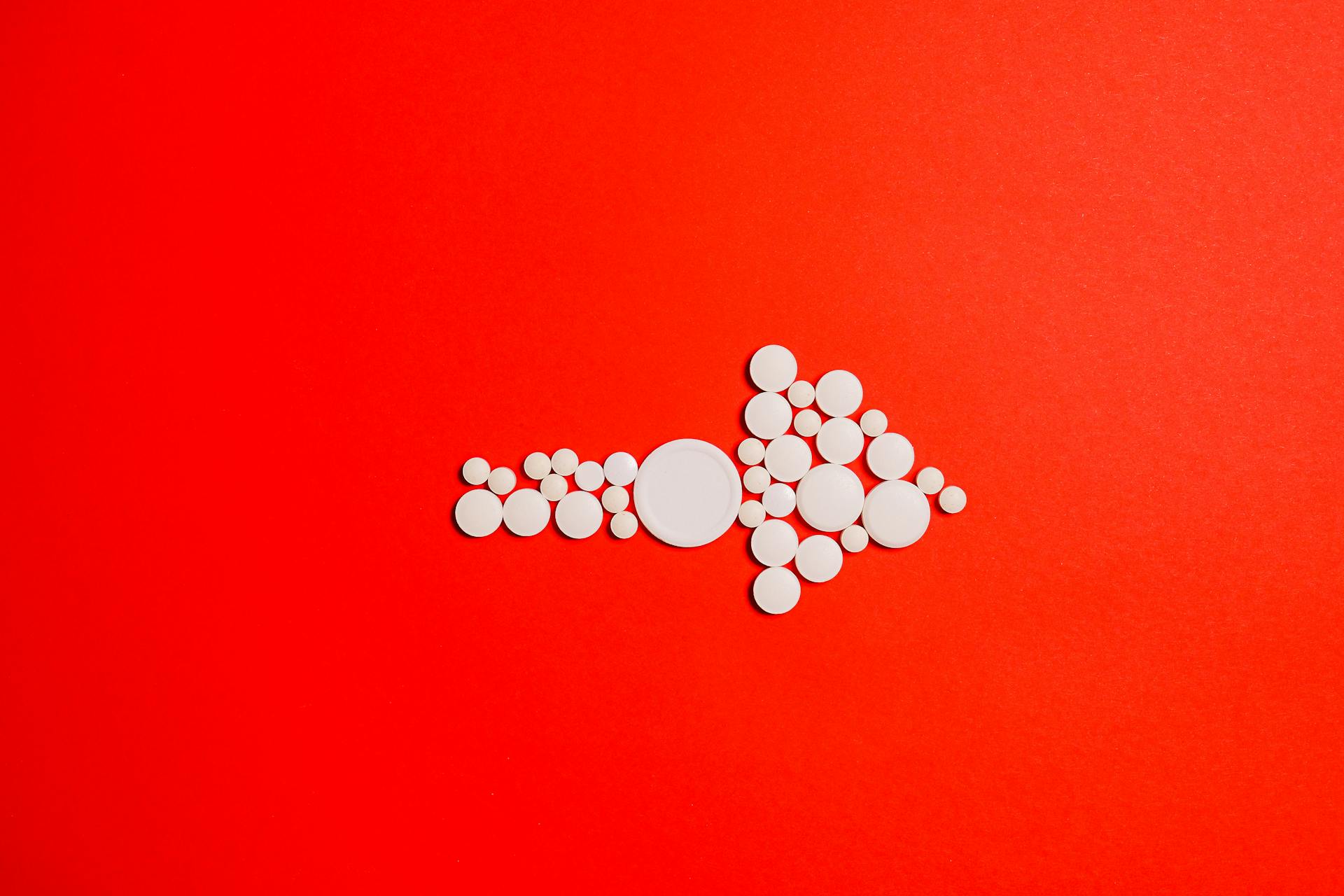
Accumulated depreciation is a crucial concept in accounting, and understanding it can help you make informed financial decisions. It's the total amount of depreciation that has been recorded on an asset over its useful life.
There are several methods to calculate accumulated depreciation, including the Straight-Line Method and the Units-of-Production Method. The choice of method depends on the type of asset and its usage.
The Straight-Line Method assumes that an asset loses value at a constant rate over its useful life. For example, a company might use this method to depreciate a machine that is expected to last for 5 years. The annual depreciation would be $20,000, resulting in a total accumulated depreciation of $100,000 after 5 years.
In contrast, the Units-of-Production Method is used for assets that have a variable lifespan, such as machinery used in manufacturing. This method calculates depreciation based on the number of units produced.
Additional reading: What Is Straight Line Depreciation Method
What Is Accumulated Depreciation?
Accumulated depreciation is a way for businesses to track the decrease in the value of their assets over time. It's a contra asset account on the balance sheet that offsets the balance in the asset account it's normally associated with.
Accumulated depreciation is calculated by crediting depreciation expenses against the assets, which increases its value. This is a key concept in accounting for assets that lose value over time.
The following assets typically have accumulated depreciation: buildings, machinery, office equipment, furniture, fixtures, and vehicles. These assets are expected to deliver positive benefits for more than one year, but their value decreases over time.
To find the accumulated depreciation, you can subtract the salvage value from the asset's original cost, divide the result by the asset's useful life, and multiply by the number of years. This calculation helps businesses make informed decisions about when to replace and repair their assets.
Accumulated depreciation is recorded as a contra asset with a natural credit balance instead of an asset account with natural debit balances. This means that a credit to a contra asset account increases its value, whereas a debit decreases it.
Here's a list of common assets that accumulate depreciation:
- Buildings
- Machinery
- Office equipment (e.g., computers)
- Furniture
- Fixtures
- Vehicles
Accumulated depreciation is a crucial aspect of accounting for assets that lose value over time. By understanding how it works, businesses can make informed decisions about their assets and improve their financial management.
Calculating Accumulated Depreciation
Calculating accumulated depreciation can be a straightforward process, but it requires a clear understanding of the underlying formula and methods.
There is no standard accumulated depreciation formula, but two main methods are used: straight-line and double-declining balance.
Accumulated depreciation is usually calculated from month to month, and it's essential to apply this to one of the depreciation methods, such as straight-line or double-declining balance.
To calculate accumulated depreciation, you need to identify the cost of the fixed asset, estimate its useful life, and calculate the depreciation amount to be reduced (salvage value) from the asset value each year.
The formula for calculating accumulated depreciation is: Accumulated Depreciation = Cost of Asset - Salvage Value.
You can also use the following formula: Accumulated Depreciation = (Cost of Asset - Salvage Value) / Life of the Asset * Number of Years.
There are six accepted methods for calculating depreciation, including straight line, declining balance, double-declining balance, sum-of-the-years' digits, units of production, and half-year recognition.
Curious to learn more? Check out: Cost Less Accumulated Depreciation Equals
Here are the six accepted methods for calculating depreciation:
- Straight line
- Declining balance
- Double-declining balance
- Sum-of-the-years' digits
- Units of production
- Half-year recognition
It's essential to note that the accumulated depreciation is the sum of all depreciation expenses since the date of original purchase, and it's used to match the timing of the purchase of a fixed asset to the economic benefits received.
Methods of Depreciation
There are several methods to calculate accumulated depreciation, each with its own unique approach. The straight-line method is the easiest way to calculate accumulated depreciation, depreciating assets at an equal amount over each year for the rest of its useful life.
To calculate accumulated depreciation with the straight-line method, you'll need to know the asset's purchase price, salvage value, and useful life. For example, if a business purchases a new machine for $30,000 with a salvage value of $5,000 and a useful life of 10 years, the annual depreciation would be $2,500.
The declining balance method, on the other hand, weighs the asset's depreciation more heavily upfront, assuming the asset receives the most use when it's new. This method is often used for assets like electronic equipment or vehicles.
Here are the main depreciation methods:
Straight-Line
The straight-line method is a simple way to calculate depreciation. It assumes that an asset loses its value at a constant rate over its useful life.
To use the straight-line method, you need to know the asset's purchase price, salvage value, and useful life. The formula for annual depreciation is straightforward: (Purchase Price – Salvage Value) / Years in Useful Life.
For example, let's say you buy a machine for $30,000 with a salvage value of $5,000 and a useful life of 10 years. Your annual depreciation would be $2,500, which means your asset loses $2,500 in value each year.
To calculate monthly depreciation, you simply divide the annual total by 12. In this case, that would be $2,500 / 12, or approximately $209.33 per month.
Here's a simple way to break down the steps:
- Subtract the asset's salvage value from its purchase price to determine the amount that can be depreciated.
- Divide the amount from Step 1 by the number of years in the asset's useful life to get annual depreciation.
This method is great for businesses with assets that have a long useful life, as it provides a clear and predictable depreciation schedule.
Double-Declining Balance
The double-declining balance method is a popular way to depreciate assets, especially for those with a shorter useful life. This method uses a depreciation rate of 2, which is twice the rate of the straight-line method.
The formula for the double-declining balance method is (Purchase Price – Salvage Value) X (1 / Years in Useful Life) X 2. Let's take the example of a company vehicle purchased for $50,000 with a salvage value of $10,000 and a useful life of 10 years.
You would calculate the depreciation expense for each year by following the formula and subtracting the total depreciation expense from the purchase price. For Year 1, the annual depreciation expense would be $8,000, and for Year 2, it would be $6,400.
Here's a breakdown of the depreciation expenses for the first 10 years:
The double-declining balance method can also be calculated using a formula: D-DBMR = (100% ÷ ULY) × 2, where D-DBMR is the double-declining balance method rate, and ULY is the useful life in years.
Sum of Years' Digits (SYD)
The Sum of Years' Digits (SYD) method is a simple way to calculate accumulated depreciation. This method is based on the formula: Depreciation Expense = (Remaining Useful Life / Sum of The Years' Digits) x Depreciable Cost.
To calculate the sum of the years, you need to know the projected useful life and add up the digits from highest to lowest. For example, an asset expected to last for five years would have a sum of 3 + 2 + 1 = 6.
The SYD method is a useful tool for businesses to accurately calculate depreciation and make informed financial decisions.
Frequently Asked Questions
Would Accumulated depreciation be a debit or credit?
Accumulated depreciation is recorded as a credit on the balance sheet. It offsets the value of the asset, reducing its net value.
Sources
- https://www.educba.com/accumulated-depreciation-formula/
- https://gocardless.com/en-us/guides/posts/what-is-accumulated-depreciation-formula/
- https://www.patriotsoftware.com/blog/accounting/what-is-accumulated-depreciation/
- https://www.wallstreetprep.com/knowledge/accumulated-depreciation/
- https://www.investopedia.com/terms/a/accumulated-depreciation.asp
Featured Images: pexels.com


